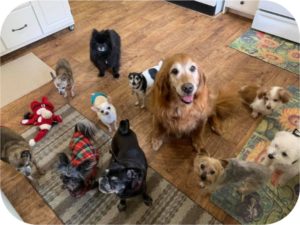Dog Roles
I’ve been thinking about how people interact with each other, which—predictably—leads me to think about dogs and how they interact with each other. First, let’s talk about people:
Human to human interaction is largely driven by relationships. You probably wouldn’t talk to your grandmother in the same way you converse with your teen-age son, nor would you share personal information with the checker at Safeway in the same way you do with your best friend. Our relationships are based on experiences—our history with other people—and those experiences color our interactions.
Our interactions are also driven by common causes. You may not know all of the people who are involved in a particular organization—like Old Dog Haven for example—but because you have a common bond with them based on relationships with senior dogs, your interactions with them are informed by that shared belief in the dignity and value of senior dogs.
So, what about dogs? What causes them to interact with each other in certain, sometimes very specific, ways? Do their experiences influence their interactions too? Probably yes in some cases, but what about the interactions that don’t seem based on experience?
Here’s an example: My friend Joey—off on another adventure now—came to live with me at a time when there were three other dogs in residence. Joey hadn’t met any of these other dogs before he came home from the shelter with me, but within a matter of hours I watched him interact in a different way with each dog. He saw Harper as his dad—even though he was older than Harper. I watched him defer to Harper, follow his lead, and generally be very “son-like” with him. Then there was his interaction with Molly; Joey was polite with her, as she was with him, but there wasn’t really much of a connection between them. Acquaintances maybe. And Fitz. Fitz was damaged in many ways, and I watched Joey tune in to the insecurity and sadness that Fitz carried around with him, and it was as if Joey wrapped his paws around Fitz emotionally, and very rarely left his side.
You may be wondering if Joey’s experiences with other dogs played a part in his interaction with Harper, Molly and Fitz but Joey was an only dog, and he had lived with one person for all of his ten years. His human was very reclusive and never socialized Joey with other dogs. When his person died Joey was brought to the shelter and didn’t interact with other dogs at all.
Here’s what I think: Because dogs process everything emotionally they feel their connections with other dogs, (just like they do with us) and often those connections aren’t influenced by experience. Dogs relate to each other in ways that are based on need and a kind of intuitive understanding. Watch your own dogs and you’ll see that there are interesting dynamics going on as they interact with each other. You’ll see friends, relatives, and casual acquaintances dancing to music only they can hear. You’ll see playfulness, aloofness, trust, and even total disinterest as they do their dance with each other.
So, what’s the point here? I don’t have a clue; I just find it interesting to notice how dogs interact with each other. I guess part of my fascination has to do with the fact that dogs just cut to the chase and they move right past preconceived ideas and just go with what they feel as they live their lives.
Maybe another lesson we could learn.


